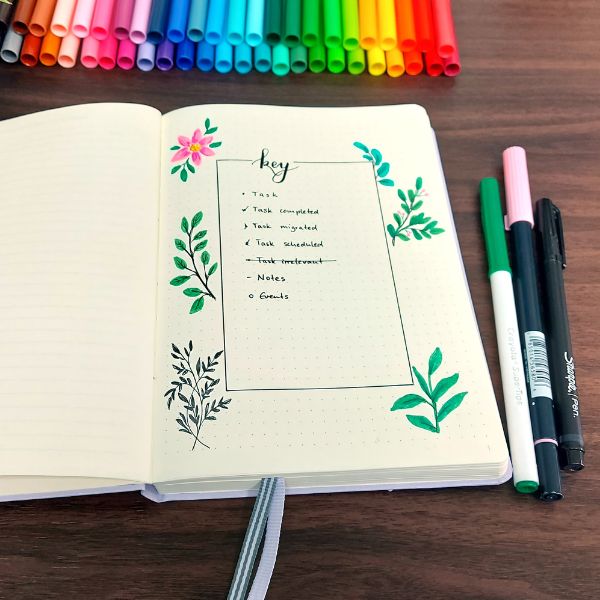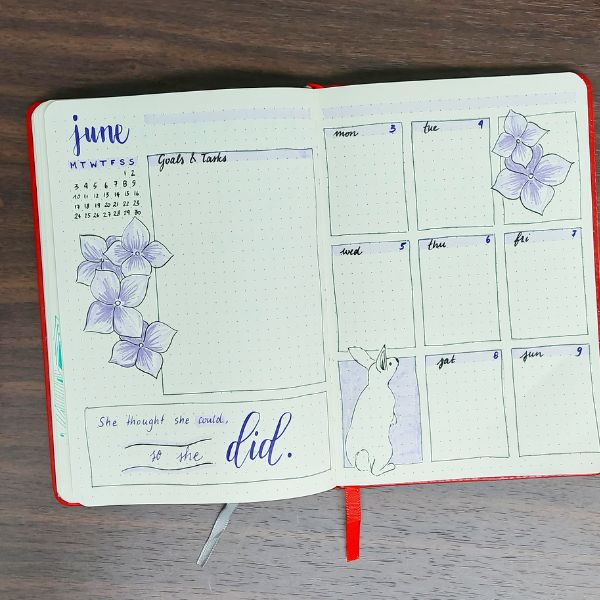Unleash Your Inner Organizer
Are you ready to take control of your life and supercharge your productivity? Welcome to this guide on how to bullet journal – a revolutionary method designed to help you organize your tasks, track your habits, and unleash your creativity like never before. Created by Ryder Carroll, the bullet journal method has taken the planning world by storm, offering a flexible and customizable approach to journaling that adapts to your unique needs and preferences.

This comprehensive guide will walk you through becoming a bullet journal pro. From setting up your journal to mastering essential techniques, you’ll learn everything you need to know to harness the power of the bullet journal method and unlock your full productivity potential. Get ready to transform your life, one bullet at a time!
The Bullet Journal is an analog system designed to track the past, organize the present, and plan for the future.
– Ryder Carroll, Inventor of the Bullet Journal method
How to Bullet Journal: Rapid Logging and Migration
Rapid logging is the cornerstone of the bullet journal method, allowing you to capture tasks, events, and notes with speed and simplicity. Each entry is written in short, concise sentences, using bullet points to categorize different types of information. For example, a dot signifies a task, a circle represents an event, and a dash indicates a note. Rapid logging lets you record information in real time, keeping your journal up-to-date and actionable.
Migration is reviewing your tasks and deciding what to do with them next. Review your open tasks at the end of each month and determine whether they align with your goals and priorities. Still relevant tasks can be migrated to the next month, while those no longer necessary can be crossed out or discarded. Migration helps you focus on what matters and prevents tasks from falling through the cracks.
Understanding the Difference Between Collections, Spreads, and Logs
Collections are themed pages that gather related information in one place. They can range from simple lists to more elaborate trackers and logs. Examples of collections include reading lists, gratitude journals, and habit trackers. Collections allow you to organize information in a way that makes sense to you, helping you stay focused and motivated on your goals.
Spreads are two-page layouts that plan specific periods, such as monthly and weekly spreads. Spreads provide a visual overview of your schedule and goals, allowing you to see everything at a glance. Depending on your needs and preferences, they can include calendars, to-do lists, habit trackers, and more.
Logs are chronological records of events, tasks, and notes. Daily logs capture your activities and priorities on a day-to-day basis, while future logs and monthly logs help you plan ahead and stay organized. Logs provide a snapshot of your life and allow you to track your progress over time.
Here are a few ideas of typical bullet journal pages:
-
-
- Books to read or movies to watch
- Favourite quotes
- Weekly meal planner
- Savings tracker
- Expenses chart
- Workout Log
- Weight loss chart
- Habit Tracker
- Week at a glance
- Daily tasks
- Places to visit
-
How to Bullet Journal Step-by-Step Guide
Step 1: Gather Your Supplies
Before diving into the world of bullet journaling, it’s essential to gather the necessary supplies. All you need is a notebook and a pen – it’s that simple!
Check out these 6 super simple page layouts to get you started now.
Opt for a notebook with a dot grid or blank pages, as they provide the flexibility needed for bullet journal layouts. Of course, you can use any journal that you have or like. I started with lined journals and worked my way up to a dot grid. Now, I don’t ever want to go back to lined, but it was an excellent start to see if I liked this type of journaling. As for pens, choose ones that won’t bleed through the pages and feel comfortable to write with.
With your supplies in hand, you’re ready to embark on your bullet journaling journey!
Discover more
Check out these 10 essential supplies for Bullet Journaling Success
Step 2: Set Up Your Key

The key is the backbone of the bullet journal method, helping you quickly categorize tasks and events. Start by creating a legend that assigns symbols to different types of entries – for example, a dot for tasks, a circle for events, and a dash for notes. Customize your key to suit your preferences, and don’t forget to leave space for future additions as your journal evolves.
Step 3: Set Up Your Index

The index is your bullet journal’s roadmap, helping you easily navigate your entries. Some journals already come with an index, simplifying the setup process. If your journal does not already have this pre-printed, reserve the first few pages for the index, where you’ll list the page numbers of key spreads and collections. As you add new entries, update the index to track where everything is located. The index ensures you can quickly find important information whenever needed, making your bullet journal more efficient and organized.
Step 4: Create Your Future Log

In the future log, you’ll jot down upcoming events, appointments, and deadlines for the months ahead. Divide your page into sections for each month, leaving enough space to write down important dates. As new events arise, add them to your future log to keep track of your schedule at a glance.
Step 5: Set Up Your Monthly Spread

At the beginning of each month, create a monthly spread to plan your goals and priorities. Use a two-page spread to write down important dates, goals, and tasks for the month ahead. Consider adding a habit tracker to monitor your progress on daily habits and routines. Your monthly spread is a roadmap for the coming weeks, keeping you focused and on track toward your goals.
Discover more
15 Creative Bullet Journal Monthly Spreads for Busy Professionals
Step 6: Create Your Weekly Spreads

Weekly spreads provide a snapshot of your upcoming week, allowing you to plan your schedule and priorities in detail. Design your weekly spread layout to include space for each day of the week and sections for tasks, events, and goals. Consider incorporating a habit tracker or meal planner into your weekly spread to keep track of recurring activities and routines. Customize your weekly spreads to suit your needs and preferences, whether you prefer a structured layout or a more minimalist approach. Review and update your weekly spreads regularly to stay on top of your commitments and make adjustments as needed.
Read more
7 Ways Bullet Journaling Weekly Spreads Boost Productivity and Creativity
Step 7: Dive Into Daily Logging

The heart of the bullet journal method lies in daily logging—the process of rapidly logging tasks, events, and notes on a daily basis. Start a new page in your journal each day and jot down the tasks you need to accomplish. Use your key to mark tasks as completed, migrated, or scheduled for a later date. Rapid logging lets you capture information quickly and efficiently, keeping your journal clutter-free and easy to navigate.
And what about the surprising benefits?
Bullet journaling is about flexibility—it can be as simple or creative as you like. It is YOUR system! If it starts to feel like a chore, remember why you started and change your approach. Intersperse your logs with an inspirational quote, photos, or cut-outs from magazines. Anything that inspires you can go into this system. Remember, the system is there for you, not the other way around.
Bullet journaling is about reducing stress. The manual task of writing things down acts as a brain dump. When your mind is frantically trying to remember everything or is stuck on one idea or task, the act of writing things down quiets your mind, giving you the ability to let go, even if it is just a little bit.
Bullet journaling is about self-motivation. Setting and reviewing your goals every day, week, and month keeps you motivated to see them through. By tracking your achievements, you will become quickly aware of your progress, which will fuel your motivation further.
Last but not least, bullet journaling is great for achieving your goals. By being organized and tracking your progress, you will find yourself on the path to success when it comes to achieving your goals. Every Sunday, when you plan your week ahead, or whenever you want to do this, you organize your thoughts, make time for things that are important to you, and ultimately create your reality.
Unleash Your Potential
Congratulations! You’ve completed your crash course in how to bullet journal and are well on your way to unlocking your productivity potential. By following the steps outlined in this guide and incorporating the tips for success, you’ll harness the full power of the bullet journal method and transform your life in ways you never thought possible.
So, are you ready to take your productivity to new heights? Start your bullet journaling journey today and unlock your full potential. Experiment with different layouts, spreads, and collections to create a journal tailored to your unique needs and preferences. Whether you’re a seasoned journaler or just starting, the possibilities are endless with bullet journaling. Get started now and watch as your productivity soars!
Do you love bullet journals but are still determining if you want to create new spreads each week?
Check out these resources that can help you on your way:
Free Resources, such as printable trackers and layouts, and build your own planner. All you need is a binder, a printer and a hole punch.
Based on the bullet journal method, our Three-Month Planner is highly customizable and provides more guidance on achieving your goals.






